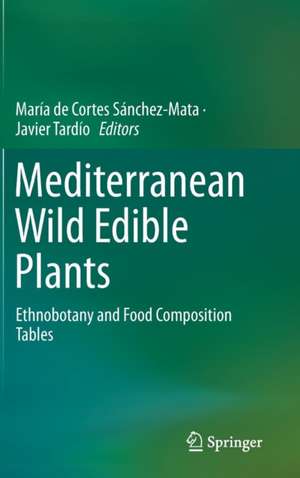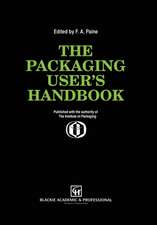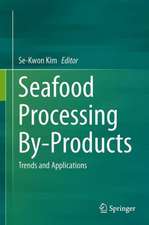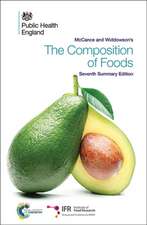Mediterranean Wild Edible Plants: Ethnobotany and Food Composition Tables
Editat de María de Cortes Sánchez-Mata, Javier Tardíoen Limba Engleză Hardback – 13 apr 2016
| Toate formatele și edițiile | Preț | Express |
|---|---|---|
| Paperback (1) | 1119.35 lei 6-8 săpt. | |
| Springer – 14 apr 2018 | 1119.35 lei 6-8 săpt. | |
| Hardback (1) | 1391.60 lei 6-8 săpt. | |
| Springer – 13 apr 2016 | 1391.60 lei 6-8 săpt. |
Preț: 1391.60 lei
Preț vechi: 1697.06 lei
-18% Nou
Puncte Express: 2087
Preț estimativ în valută:
266.31€ • 289.18$ • 223.70£
266.31€ • 289.18$ • 223.70£
Carte tipărită la comandă
Livrare economică 22 aprilie-06 mai
Preluare comenzi: 021 569.72.76
Specificații
ISBN-13: 9781493933273
ISBN-10: 1493933272
Pagini: 469
Ilustrații: XII, 478 p. 71 illus.
Dimensiuni: 155 x 235 x 35 mm
Greutate: 8.57 kg
Ediția:1st ed. 2016
Editura: Springer
Colecția Springer
Locul publicării:New York, NY, United States
ISBN-10: 1493933272
Pagini: 469
Ilustrații: XII, 478 p. 71 illus.
Dimensiuni: 155 x 235 x 35 mm
Greutate: 8.57 kg
Ediția:1st ed. 2016
Editura: Springer
Colecția Springer
Locul publicării:New York, NY, United States
Cuprins
Preface.- A Historical Perspective of Wild Plant Foods in the Mediterranean Area.- The Mediterranean Landscape and Wild Edible Plants.- Nutritional Ethnnobotany in Europe: From Emergency Foods to Healthy Folk Cuisines and Contemporary Foraging Trends.- Ethnobotanical Analysis of Wild Fruits and Vegetables Traditionally Consumed in Spain.- Natural Production and Cultivation of Mediterranean Wild Edibles.- The Contribution of Wild Plants to Dietary Intakes of Micronutrients (I): Vitamins.- The Contribution of Wild Plants to Dietary Intakes of Micronutrients (II): Mineral Elements.- Fatty Acid Profiles of Mediterranean Wild Edible Plants.- Wild Edible Plants As Sources of Carotenoids, Fibre, Phenolics and Other Non-nutrient Bioactive Compounds.- Antioxidant Potential of Wild Plant Foods.- Antimicrobial Potential of Wild Edible Herbaceous Species.- Recent Advances in Research on Wild Food Plants and Their Biological-Pharmacological Activity.- Ethnobotanical and Food Composition Monographs of Selected Mediterranean Wild Edible Plants.
Recenzii
“Chapters on the contribution of wild plants to dietary intakes do a nice job of connecting the kinds of nutritional data presented in the monographs to functions of those nutrients in the human body. Excellent use is made of photographs, in particular as they are gathered together to illustrate different aspects of one theme. … a vast amount of pertinent information is crammed into the book.” (Susanne Masters, Economic Botany, Vol. 70 (4), December, 2016)
Notă biografică
Dr. María de Cortes Sánchez-Mata, PhD in Pharmacy, is currently a professor in Food Science at the Faculty of Pharmacy, Complutense University of Madrid, Spain. She has performed a continuous research on the analysis of nutrients, antinutrients and bioactive compounds in plant foods, with the focus on human health promotion.
Dr. Javier Tardío, PhD in Agricultural Engineering, is currently a researcher at IMIDRA (Madrid Institute for Rural Development, Agriculture and Food Research), in Madrid, Spain. He has maintained an active research on different aspects of Ethnobotany, especially on Mediterranean wild edible plants.
Dr. Javier Tardío, PhD in Agricultural Engineering, is currently a researcher at IMIDRA (Madrid Institute for Rural Development, Agriculture and Food Research), in Madrid, Spain. He has maintained an active research on different aspects of Ethnobotany, especially on Mediterranean wild edible plants.
Textul de pe ultima copertă
This book provides the latest published nutritional data about wild edible plants traditionally consumed in the Mediterranean region. This information, not usually included in nutrient databases of foods, provides insight into the revalorization of wild food species and preservation of their traditional uses. The text also presents wild edible plants as alternatives to improve the diversity of modern Mediterranean diets, as they may represent valuable sources of nutrients often lacking in modern societies, such as fiber or vitamin B9.
This work has expanded from the two initial groups, to involve different contributors, including experts from different countries, most of them bordering the Mediterranean Sea. As a result, a multidisciplinary approach has been achieved.The book is organized into four parts that deals with different aspects of wild edible plants, the last one and largest offering a detailed compilation of ethnobotanical and nutritional information about some of the most important Mediterranean wild edible plants.
Caracteristici
Provides content not included in other books on Mediterranean ethnobotany
Utilizes a multidisciplinary approach to plant science
Analyzes the food use of many wild edible plants, widely distributed in the Mediterranean area
Utilizes a multidisciplinary approach to plant science
Analyzes the food use of many wild edible plants, widely distributed in the Mediterranean area







